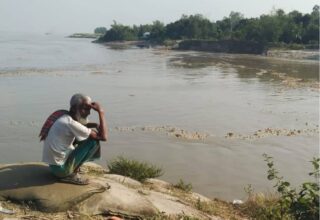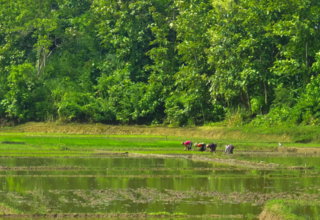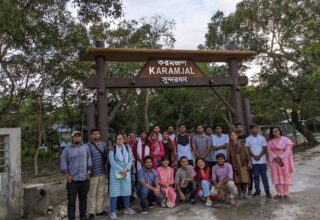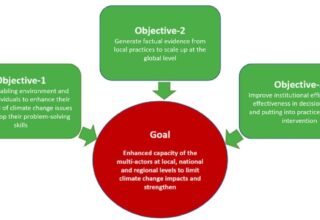(This article has originally been published here)
To the surprise of very few, Dhaka has been ranked as one of the most unlivable cities in the world. Delving deeper beneath the apparent reasons – overpopulation, pollution, and congestion – reveals a major underlying cause: unsustainable levels of climate induced displacement and migration.
“Climate change acts as a trigger for migration,” says Sheikh Tawhidul Islam, professor of the Environment and Geography Department of Jahangirnagar University. Bangladesh’s low lying coastal areas are highly vulnerable to a rising sea level, storm surges and saltwater logging. At present rates, in just 25 years salt water will ruin farmlands and poison drinking water for over 10 million people. Cyclones and floods are increasing in intensity and frequency, and so is loss of land due to riverbank erosion. The Intergovernmental Panel on Climate Change estimates that 20 million people will be displaced in Bangladesh by 2020 as a result of climate change, which is larger than the cumulative populations of Los Angeles, Chicago and New York City. Prolonged droughts are reducing arable land by causing soil erosion and damaging crops dependent on predictable patterns of monsoon. These push factors are forcing many people to seek refuge elsewhere; and with its lure of economic opportunities and an apparent better standard of living, the capital Dhaka seems to be the obvious choice.
However, Dhaka is far from being the Promised Land for climate refugees. Over 500,000 people migrate to this already overcrowded city each year, which has less than 1% of the country’s land. Given the burgeoning population and land scarcity, Dhaka’s property prices and rent continues to sky rocket and are comparable to New York and London’s real estate prices, as found by a World Bank study. Most climate refugees come from humble financial backgrounds and inevitably resort to affordable but crammed and substandard squatter settlements, known as bosti.
Bosti dwellers, 70 per cent of whom are climate refugees according to the International Orgainsation for Migration, are the most vulnerable to impacts of climate change in this flood prone city. These low lying favelas rarely have electricity, gas, water and sanitation facilities, and waterborne diseases such as diarrhea and typhoid are widespread. Currently around 40 per cent of Dhaka’s population lives in slums, their flimsy abodes often blown away by storms or washed away by floods. As unearthed by a mapping and census of slums by Dhaka’s Center for Urban Studies, a majority of Dhaka’s bostis are prone to frequent flooding and waterlogging – a cruel Déjà vu for climate refugees.
The plight of these squatter settlers does not end once they step out of slums. Most of these migrants, who used to be farmers, find their skills unusable in the city and end up doing low skill work with little job security. “It’s very hard work for little money,” says Rahmat Ali, a resident of Dhaka’s biggest slum Korail, who moved here after saltwater logged his farmland and currently works as a rickshaw puller, “But there are few options for the likes of us.” His case is representative of many migrants whose low income and poor asset base translates to low resilience to climatic events. “More and more [displaced families] are arriving here every day from villages,” accounts Ali, pointing to the alarming trend.
With ubiquitous bostis and climate refugees dominating the cityscape, better off Dhaka residents are becoming increasingly desensitised and apathetic to the plight of these slum dwellers and accepting it as the norm. Similarly, just as many weary readers are becoming desensitised to dreary statistics, such as a third of Bangladesh will be submerged due to rising sea levels by 2050.
This apathy towards climate refugees is also prevailing in the country’s policy sphere. “People are migrating to cities because the nation is not responding to their risks,” says Dr. Aminul Islam, member of the National Displacement Strategy Working Group under the Ministry of Disaster Management. While the Bangladesh government has taken commendable measures for climate change adaptation, it has not yet prescribed any adaptation programmes specifically addressing climate induced internal displacement. “The country needs a long term vision for reducing displacement,” Dr. Islam says, stating that the provision for climate resilient habitat, livelihood opportunities and civil facilities for the vulnerable will reduce incentives to migrate.
“We often treat the symptoms rather than the causes,” said Professor Sheikh Tawhidul Islam, adding that the climate change vulnerability drivers need to be addressed. In order to reduce the incidence of climate change induced migration in the first place, the adaptive capacity of vulnerable communities needs to be improved. This includes measures such as strengthening coastal embankments to minimise risks of flooding, disbursement of drought and salinity resistant seeds to farmers, rainwater harvesting as well as strengthening farmers’ asset base and improving access to climate related information.
In the long term, adaptation efforts by developing countries such as Bangladesh can only go so far without mitigation efforts by the major carbon emitting nations to keep global warming below 2 degrees Celsius and move towards a green economy. The world’s leaders will congregate in Paris this year with the hope of attaining a universal, binding agreement for combating climate change. However, as formal negotiations in Bonn ahead of COP 21 indicated, the emission cuts that will be agreed in Paris will not be enough to reach the objective. In this context, the next best alternative is agreement on establishing a five-yearly “review and improve” process with the commitment of scaling up gradually, making climate targets more ambitious over time and catching up with the pace of climate change.
Regardless of what naysayers believe, climate change is not something that affects only polar bears, nor is it a problem for future generations. As the case of Dhaka illustrates, the threat of climate change and the plight of climate refugees are real. The fate of this megacity on the brink of collapse depends on the Bangladesh government implementing climate adaptive strategies and the international community championing short term mitigation and long term goals of fossil fuel elimination. Failure to act now will make Dhaka’s case a precursor for a global climate catastrophe.
Written by: Sohara Mehroze Shachi







